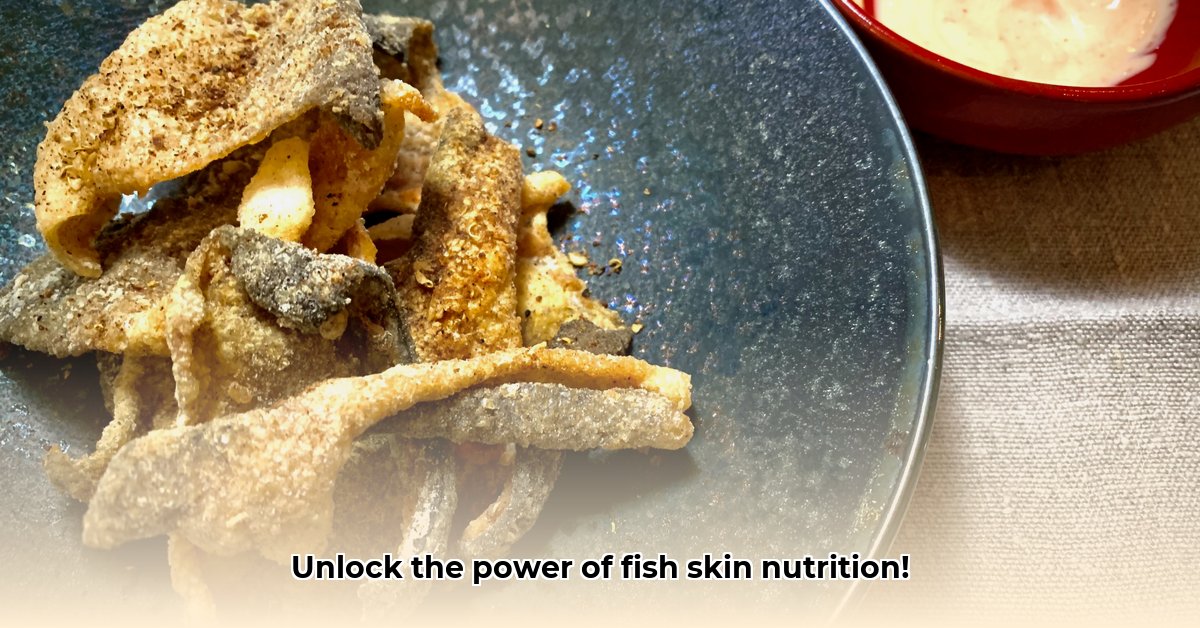Ever toss away the fish skin? It’s time to reconsider! Fish skin, often discarded, is a nutritional powerhouse brimming with protein, omega-3 fatty acids, and collagen – often lacking in modern diets. This guide provides a comprehensive exploration of fish skin, focusing on maximizing nutritional benefits while ensuring safe consumption. How to choose fish skin for delicious cooking?
The Nutritional Powerhouse: Why Eat Fish Skin?
Forget tossing that fish skin! Fish skin is a nutritional powerhouse, often overlooked, brimming with benefits you might not expect. Beyond being a delicious treat, fish skin offers a wealth of essential nutrients that can significantly boost your health. From heart-healthy omega-3 fatty acids to skin-rejuvenating collagen and muscle-building protein, this guide unveils the secrets of this often-discarded part of the fish, demonstrating how to safely and deliciously incorporate it into your diet.
Unlocking the Goodness: Key Nutrients in Fish Skin
Fish skin isn’t just a protective layer; it’s a treasure trove of nutrients. We’re talking protein, those beneficial omega-3 fatty acids that are so good for your heart, collagen for healthy skin and joints, and a mix of vital vitamins and minerals. It’s a tasty way to boost your nutrient intake.
- Protein: Essential for building and repairing tissues, protein is abundant in fish skin. It aids in muscle growth, supports a healthy immune system, and contributes to overall well-being.
- Omega-3 Fatty Acids: These essential fats are renowned for their heart-healthy and brain-boosting benefits. Fish skin, especially from fatty fish like salmon and mackerel, is a rich source of EPA and DHA, two crucial types of omega-3s.
- Collagen: This protein is a building block for healthy skin, hair, nails, and joints. Consuming fish skin is a natural way to boost your collagen intake and promote a youthful appearance.
- Vitamins & Minerals: Fish skin contains vital nutrients like Vitamin D, Vitamin E, selenium, and iodine, all of which play crucial roles in maintaining optimal health.
The exact nutritional profile varies significantly depending on the type of fish, but the overall consensus is that fish skin is a highly nutritious food source.
Safety First: Smart Choices and Preparation
While the nutritional benefits are undeniable, safety is paramount. Fish can accumulate mercury and other contaminants from their environment. Selecting the right types of fish and preparing them properly is crucial to minimize potential risks.
- Choose Low-Mercury Fish: Opt for fish known to have lower mercury levels, such as salmon, cod, tilapia, catfish, flounder, and sardines.
- Avoid High-Mercury Fish: Limit or avoid consumption of fish with high mercury levels, such as shark, swordfish, king mackerel, and tilefish.
- Source Responsibly: Purchase fish from reputable sources that adhere to strict quality control standards and sustainable fishing practices.
- Thorough Cleaning: Thoroughly clean and scale the fish skin before cooking to remove any potential contaminants and improve the taste.
- Moderation is Key: Enjoy fish skin as a part of a balanced diet. The FDA recommends eating 2-3 servings of fish per week.
Here’s a helpful guideline for choosing fish based on mercury levels:
| Fish Type | Mercury Level (General Guideline) | Frequency Recommendation |
|---|---|---|
| Salmon (wild-caught) | Generally Low | 2-3 times per week |
| Tilapia | Generally Low | 2-3 times per week |
| Cod | Generally Low | 2-3 times per week |
| Sardines | Very Low | 3 or more times per week |
| Flounder | Generally Low | 2-3 times per week |
| Tuna (albacore) | Moderate | 1 time per week or less |
| Swordfish | High | Avoid |
| King Mackerel | High | Avoid |
| Shark | High | Avoid |
Note: Mercury levels can vary depending on the fish’s age, size, and origin. Check with official government health sources for the most accurate and up-to-date information.
Preparing Fish Skin: Achieving Crispy Perfection
Transforming fish skin into a culinary delight is easier than you think! The key is to achieve that perfect crispy texture, which not only enhances the flavor but also renders out excess fat and potential contaminants.
- Thorough Cleaning: Start by meticulously cleaning and scaling your fish skin.
- Drying is Essential: Pat the fish skin completely dry with paper towels. Removing excess moisture is critical for achieving maximum crispiness.
- Seasoning Magic: Season generously with salt, pepper, and your favorite herbs and spices. Consider adding garlic powder, paprika, or lemon zest for extra flavor.
- Choose Your Cooking Method:
- Pan-Frying: Heat a small amount of oil (olive oil, coconut oil, or avocado oil) in a pan over medium-high heat. Place the fish skin in the pan, skin-side down, and cook until golden brown and crispy, about 3-5 minutes. Flip and cook for another minute or two.
- Grilling: Preheat your grill to medium-high heat. Place the fish skin on the grill, skin-side down, and cook until crispy, about 3-5 minutes.
- Baking: Preheat your oven to 400°F (200°C). Place the fish skin on a baking sheet lined with parchment paper and bake for 10-15 minutes, or until crispy.
- Serve Immediately: Enjoy the crispy fish skin straight away, as it’s best when fresh and hot.
Recipe Inspiration: Unleash Your Culinary Creativity
- Crispy Pan-Fried Fish Skin: A simple and classic preparation that highlights the natural flavor of the fish skin. Serve as a snack, appetizer, or side dish.
- Grilled Lemon Herb Fish Skin: Marinate fish skin in a mixture of lemon juice, olive oil, garlic, and your favorite herbs before grilling for a zesty and flavorful dish.
- Fish Skin Cracklings: Deep fry fish skin until puffed and crispy. Season with salt and your favorite spices for a savory snack. (Enjoy in moderation due to the high fat content.)
- Fish Skin Tacos: Use crispy fish skin as a base for delicious and unique tacos. Top with your favorite taco fillings, such as salsa, guacamole, and shredded cabbage.
- Fish Skin Salad Topping: Crumble crispy fish skin over salads for added flavor, texture, and nutrients.
The Bottom Line: A Delicious and Nutritious Addition
Fish skin is a culinary treasure that offers a wealth of nutritional benefits and delicious flavor. By choosing lower-mercury fish, preparing it safely, and experimenting with different cooking methods, you can enjoy fish skin as a regular part of your balanced diet. Embrace the potential of fish skin and elevate your culinary experience!
Proven Tactics For Cooking Delicious Fish Skin For Optimal Nutrient Retention
Key Takeaways:
- Fish skin is a nutritional powerhouse, boasting protein, omega-3 fatty acids, collagen, and vitamins.
- Careful selection and preparation are crucial for safe consumption, minimizing mercury and other potential contaminants.
- Proven tactics for cooking delicious fish skin involve mastering techniques like proper drying, high-heat searing, and careful temperature control to achieve optimal crispiness and flavor.
- Further research is needed to fully understand the comprehensive nutritional benefits and potential risks associated with regular fish skin consumption.
Unlocking the Nutritional Powerhouse: Why Eat Fish Skin?
Let’s be honest, how many times have you tossed aside that perfectly good fish skin? It’s time to rethink that habit. Fish skin isn’t just a byproduct – it’s packed with nutrients! We’re talking protein, healthy omega-3 fatty acids
- Unlock ancient roman remedies: Natural treatments revealed for modern wellness. - August 17, 2025
- Unlock History: Ancient Roman Coin Necklace Trends & Buys - August 17, 2025
- Beyond Gladiators: Achievements in Ancient Rome Still Shaping Our World - August 17, 2025
















